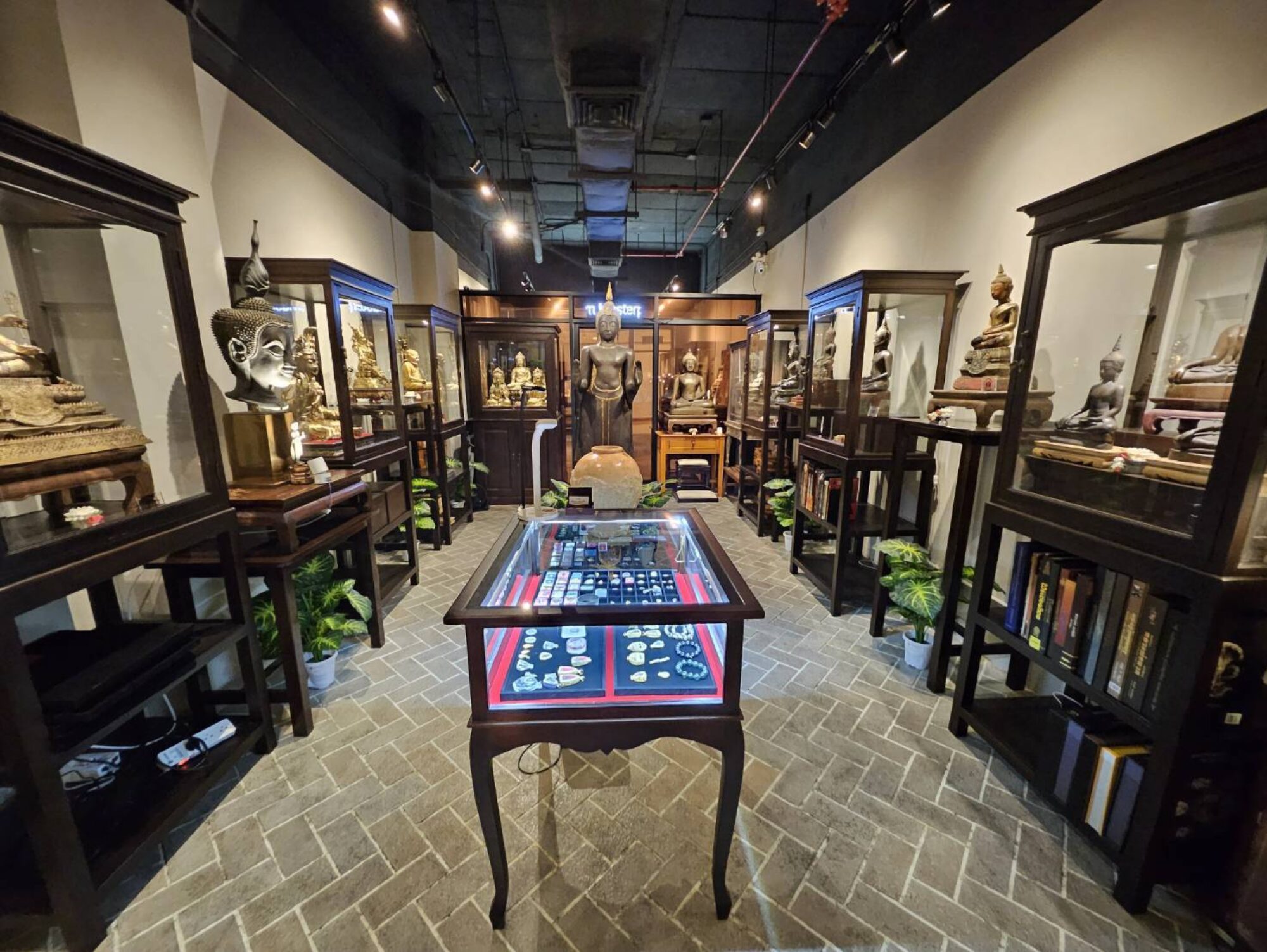
พระพุทธรูปองค์นี้มีลักษณะเป็นพระพุทธรูปนั่งปางมารวิชัย (ปางชนะมาร) ซึ่งเป็นปางที่พบได้บ่อยในศิลปะพุทธศาสนา โดยเฉพาะในประเทศจีน ทิเบต และญี่ปุ่น ลักษณะเด่นที่พอจะระบุเบื้องต้นเกี่ยวกับยุคสมัยได้มีดังนี้:
ลักษณะเด่นของพระพุทธรูป
- พระพักตร์อ่อนโยนและเมตตา
- ใบหน้ากลม พระเนตรปิดเล็กน้อยคล้ายเข้าสู่สมาธิ
- มวยผมเป็นก้นหอย (อุษณีษะ)
- บ่งบอกถึงความเป็นพระพุทธเจ้าอย่างชัดเจน
- จีวรที่บางแนบเนื้อ
- มีการพาดสังฆาฏิแบบเรียบง่ายแต่สง่างาม
- พระหัตถ์แสดงปางมารวิชัย
- พระหัตถ์ขวาวางบนพระชานุ (เข่า) ปลายนิ้วชี้ลงพื้นดิน สื่อถึงการอ้างแผ่นดินเป็นพยาน
การคาดคะเนยุคสมัย
- จากลักษณะศิลปะและวัสดุ (สำริดปิดทอง) อาจเป็นงานศิลปะ จีนสมัยราชวงศ์หมิง (ค.ศ. 1368–1644) หรือ ราชวงศ์ชิง (ค.ศ. 1644–1912)
- ศิลปะสมัยนี้มีอิทธิพลจากมหายาน และนิยมแสดงพระพุทธรูปในอิริยาบถที่สง่างามและประณีต
พระพุทธรูปองค์นี้เป็น พระพุทธรูปปางมารวิชัย (ปางชนะมาร) ซึ่งมีความสำคัญทางศาสนาและประวัติศาสตร์ในพระพุทธศาสนา ลักษณะขององค์พระและรายละเอียดบ่งบอกว่าเป็นงานศิลปะที่ได้รับอิทธิพลจากพุทธศิลป์แบบ จีนโบราณ หรือ ธิเบตซึ่งเชื่อมโยงกับนิกายมหายาน
ตำนานและความเป็นมา
ตำนานของปางมารวิชัยเกี่ยวข้องกับช่วงเวลาที่พระพุทธเจ้าทรงตรัสรู้ใต้ต้นโพธิ์ หลังจากการบำเพ็ญเพียรมายาวนาน พระยามารและเหล่ามารบริวารได้พยายามขัดขวางและโจมตีพระพุทธเจ้า ทั้งด้วยกิเลสและอารมณ์โลภ โกรธ หลง แต่พระองค์ทรงมีจิตมั่นคง และใช้ “ปัญญา” เป็นอาวุธในการเอาชนะมาร
พระพุทธองค์จึงทรงชี้พระหัตถ์ลงพื้นดิน อ้างแผ่นดินเป็นพยานถึงบารมีที่ได้สั่งสมมาหลายชาติภพ แผ่นดินจึงสั่นสะเทือนและส่งเสียงรับรอง จนทำให้มารต้องพ่ายแพ้ไป สะท้อนถึงชัยชนะของธรรมะเหนืออธรรม
ความศักดิ์สิทธิ์และความศรัทธา
พระพุทธรูปปางนี้ได้รับการเคารพอย่างแพร่หลาย เนื่องจากเป็นสัญลักษณ์ของชัยชนะ ความเพียร และการบรรลุธรรม
พลังศักดิ์สิทธิ์ที่เชื่อถือกัน
- ป้องกันอุปสรรคและสิ่งชั่วร้าย
- ช่วยปกป้องคุ้มครองผู้บูชาให้พ้นจากภยันตราย อุปสรรคต่าง ๆ
- เสริมสร้างปัญญาและความมั่นคงทางจิตใจ
- เหมาะสำหรับผู้ที่แสวงหาปัญญา ความรู้ และความสำเร็จในชีวิต
- หนุนนำความสำเร็จและโชคลาภ
- เชื่อกันว่าช่วยเสริมดวงด้านการงาน การเงิน และธุรกิจ
การบูชาและการครอบครอง
การบูชาพระพุทธรูปองค์นี้ควรดำเนินการด้วยความเคารพและศรัทธา
การตั้งบูชา
- วางไว้ในที่สูงและสะอาด หันหน้าไปทางทิศตะวันออกหรือทิศเหนือ
- ประดับด้วยดอกบัวหรือดอกไม้หอม เพื่อแสดงความเคารพ
บทสวดมนต์บูชา
- ตั้งนะโม 3 จบ
- สวดบทบูชาพระพุทธคุณ:
Copy codeอิติปิ โส ภะคะวา อะระหัง สัมมา สัมพุทโธ วิชชาจะระณะสัมปันโน สุคะโต โลกะวิทู
อะนุตตะโร ปุริสะทัมมะสาระถิ สัตถา เทวะมะนุสสานัง พุทโธ ภะคะวาติ
- อธิษฐานขอพรตามความปรารถนาโดยมุ่งเน้นความตั้งใจบริสุทธิ์
ความเหมาะสมในการครอบครอง
- เสริมพลังในการเอาชนะอุปสรรคในชีวิต
- ส่งเสริมความมุ่งมั่นและความสำเร็จในหน้าที่การงาน
- ช่วยเสริมบารมีและปกป้องคุ้มครองชีวิตครอบครัวให้สงบสุข
Seated Buddha in Mara-Vijaya posture (Victory over Mara) during the Ming or Qing Dynasty
This Buddha image is in the form of a seated Buddha in Mara-Vijaya posture (Victory over Mara), which is a posture that is often found in Buddhist art, especially in China, Tibet, and Japan. The distinctive features that can be initially identified regarding the era are as follows:
Distinctive characteristics of the Buddha image
Gentle and compassionate face
Round face, slightly closed eyes, as if in meditation
Hair in a snail-shaped bun (Ushnisha)
Clearly indicating the Buddha’s identity
Thin robes that cling to the body
Simple but elegant draping of the sangkhati
Hands in the Mara-Vijaya posture
Right hand placed on the knee, fingertips pointing to the ground, indicating the claim of the land as witness
Estimation of the era
Based on the art style and materials (bronze covered in gold), it may be a work of art China during the Ming Dynasty (1368–1644) or Qing Dynasty (1644–1912)
The art of this period is influenced by Mahayana and is popular to show Buddha statues in graceful and refined postures.
This Buddha statue is the Mara-Vijaya Buddha statue (the posture of defeating Mara), which has religious and historical significance in Buddhism. The characteristics of the Buddha statue and its details indicate that it is an art work influenced by ancient Chinese or Tibetan Buddhist art, which is linked to the Mahayana sect.
Legend and Background
The legend of the Mara-Vijaya posture relates to the time when the Buddha attained enlightenment under the Bodhi tree after a long period of asceticism. Mara and his followers tried to obstruct and attack the Buddha with their lust and emotions of greed, anger, and delusion. However, he had a steadfast mind and used “wisdom” as a weapon to defeat Mara.
The Buddha then pointed his hand to the ground, citing the ground as a witness to the merit he had accumulated over many lifetimes. The ground shook and made a sound of approval, causing Mara to be defeated. Reflecting the victory of righteousness over evil
Sacredness and faith
This Buddha image is widely revered as a symbol of victory, perseverance and the attainment of enlightenment.
Believed sacred power
Protects against obstacles and evil
Helps protect worshipers from dangers and obstacles
Enhances wisdom and mental stability
Suitable for those seeking wisdom, knowledge and success in life
Promotes success and fortune
Believed to enhance luck in career, finance and business
Worship and possession
Worship of this Buddha image should be done with respect and faith.
Placement of worship
Place in a high and clean place, facing east or north.
Decorate with lotus or fragrant flowers to show respect.
Prayer for worship
Chant Namo 3 times
Chant the prayer for the virtues of the Buddha:
Copy code
Itipi So Bhagava Arahang Samma Samputtho Wichjacarana Sampanno Sukato Lokavidu
Anuttaro Purisa Tammasarathi Sattha Deva Manussanang Puttho Bhagavati
Pray for the blessings according to your wishes by focusing on pure intentions
Suitability of possession
Enhance the power to overcome obstacles in life
Promote determination and success in work
Help enhance charisma and protect family life to be peaceful
明清时期的摩罗坐佛像(Chana Mara 姿势)。
这尊佛像的外观为马拉维猜式(Pang Chana Mara)坐佛,这是佛教艺术中常见的姿势。特别是在中国、西藏和日本,以下是这个时代可以识别的一些基本特征:
佛像的突出特点
他的脸温柔而慈祥。
他的脸圆圆的,眼睛微闭,像是在冥想。
螺旋发髻(Usaneetha)
它清楚地表明了佛陀的身份。
贴身薄的长袍
僧伽的披饰简单而优雅。
他的手展现了马拉维奇的姿势。
右手放在胸口(膝盖)上,指尖指向地面。作为证人提及声称拥有土地
时代的估计
从艺术特点和材质上(镀金青铜)可能是一件艺术品中国明朝(1368-1644)或清朝(1644-1912)。
现代艺术深受大乘艺术的影响。并流行展示姿态优雅、脱俗的佛像。
这尊佛像是马拉维猜 (Pang Chana Mara) 姿势的佛像在佛教中具有宗教和历史重要性。佛像的外观和细节表明它是一件受中国古代或藏传佛教艺术影响的艺术品,与大乘教派有联系。
传说与历史
马拉维猜 (Maravichai) 的传说与佛陀在菩提树下成道时有关。经过长时间的练习魔罗王子及其部下试图阻挡和攻击佛陀。都有贪、嗔、痴的欲望和情绪,但陛下心态稳定,以“智慧”为武器,战胜了魔鬼。
佛陀随即将手指向地面。声称这片土地是多世积累的功德的见证。大地颤抖起来,声音也提高了。直到必须打败魔鬼体现了佛法对邪恶的胜利。
圣洁与信心
此佛像广受尊崇。因为它是胜利、毅力和成就的象征。
值得信赖的神圣力量
抵御障碍和邪恶事物。
帮助保护信徒免受危险和各种障碍。
增强智力和心理稳定性
适合那些寻求智慧、知识和人生成功的人。
促进成功和财富
人们相信它可以改善你的工作、财务和商业运气。
崇拜和占有
供奉此佛像应怀有尊敬和信心。
崇拜
将其放置在高处且干净的地方。朝东或朝北
饰以莲花或香花。以表示尊重
敬拜祷告
设置 Namo 3,已完成
念诵供佛礼佛:
复制代码
Itipi so bhagava arahan sammā sambuddho vijjācaranasampanno sukato lokāvīdū。
Anuttaro Purisadammasarathi satthā devamanussanaṃ buddho bhagavati。
以纯粹的意图为您的愿望祈祷。
占有的适当性
增强克服生活障碍的能力。
促进您职业生涯的承诺和成功。
有助于提升威望,保佑家庭生活安宁。
